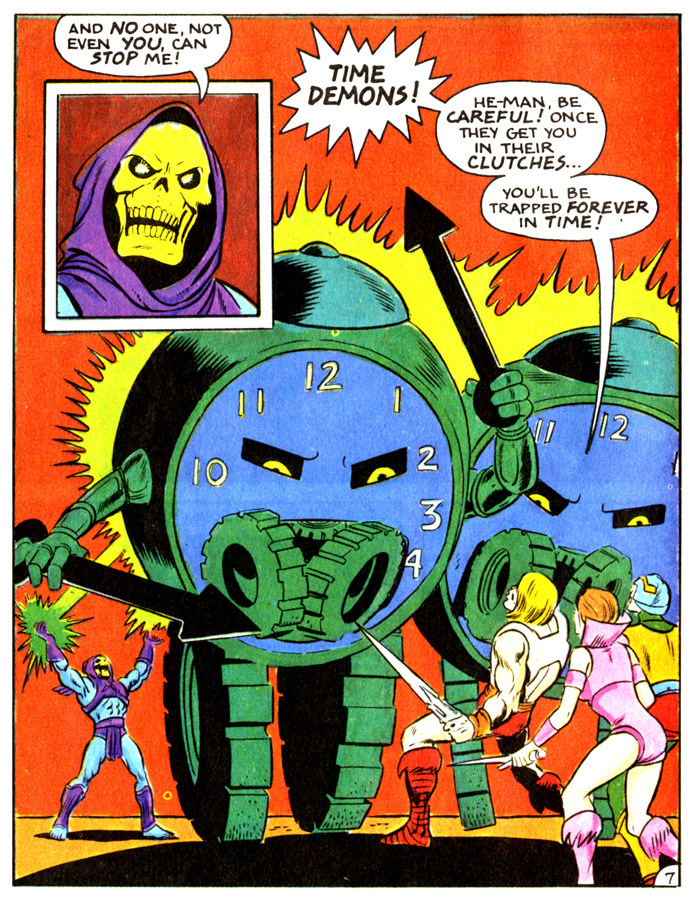Skeletor is the principle antagonist of the so-called Masters of the Universe myth and literary cycle. His inhuman physical appearance, magical power, and dedication to conquering Eternia through usurpation of the power of Castle Grayskull are consistent throughout the various stories, but other aspects of his character, including his origins and the seriousness of his menace, vary wildly.
It has long been the prevailing view among scholars that his depiction as blue skinned links him to the Gar people1. The Gar civilization existed on the so-called Dark Hemisphere of Eternia, but came into conflict with groups on the Light Hemisphere in the islands of the Ocean of Gnarl and on the land bridge between the continents. By the time of the Randorian Renaissance, the Gar were a ethnic minority who suffered a good deal of prejudice owing to the belief that a Councilor of their ethnicity had betrayed and murdered the founding hero King Grayskull in the service of King Hiss of the Serpent Men2.
Later stories explicitly make Skeletor King Randor's brother Keldor who was transformed by forbidden magic, in some versions specifically Hordak worship. While the identification is not without controversy, Keldor was depicted as Gar, or at least half-Gar. There are scholars that argue that Keldor himself is a fiction created for later anti-Gar polemics, but the more common view is the he was indeed Randor's half-brother, a perhaps the illegitimate offspring of Miro and a Gar woman. Keldor was, for a time, a serious rival to Randor's power owing in part to a strong powerbase among traditionalist Gar clans.
Skeletor, however, existed in myth and legend prior to his association with Keldor. He was depicted as an otherworldly or demonic entity who had arrived on Eternia through accident or intention, but now wished to re-open that portal to bring his people through to aid in his conquest.
What is likely the oldest known legend associating the two is curiously restrained regarding the specifics of their relationship. Keldor is shown as meddling in dangerous magic and disappearing after a mishap. Skeletor is depicted as attempting to thwart any investigation into Keldor's current whereabouts. The gaps n the narrative invite the audience to assume that Skeletor and Keldor one and the same, but do not make the link explicitly. It is argued that this structure is an indicator of the stories origins as Randorist propaganda either during the time when the throne was contested or shortly after Randor secured it. Further, the effectiveness of such propaganda would hinge on Skeletor as a character already known to the intended audience.
It could be that Skeletor's pre-existing Gar traits made this linkage with Keldor possible, but it is also possible that Skeletor's Gar coloration is a later addition. Certainly it is no accident that Skeletor's shade of blue has a long association with the supernatural in the Eternian mind. It has been suggested that both the Gar people and Skeletor are depicted as blue simply because of the rarity of the blue pigments in the Light Hemisphere used in art in the Gar ruins on Anwat Gar to depict rulers such as Shokoti and the persist association of the Gar with magic due to their status as diviners and purveyors of charms and curses.
Recently, archeological evidence of a skull faced god or demon that appears to have been the focus of ritual activity in the region around Castle Grayskull in the putative era of the first "He-man." Any correlation of this entity with Skeletor or the Gar is highly speculative.
______________________________________________
1. The Gar were typically depicted as blue-skinned. Whether they literally were, either naturally or as some form of body-adornment, or this depiction has symbolic significance is unknown.
2. If there is any truth to this allegation at all, it likely conveys persistent Serpos worship among the Gar during the period where Goddess worship was becoming dominant on the Light Hemisphere.






























































